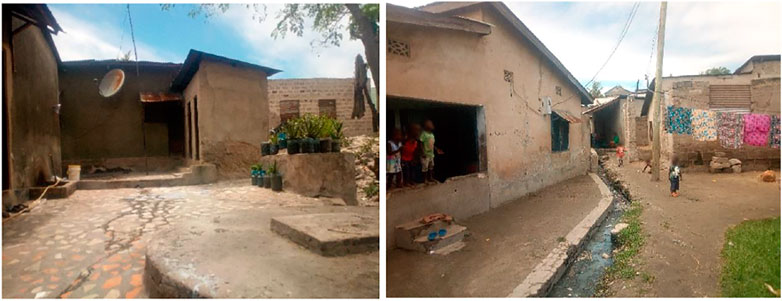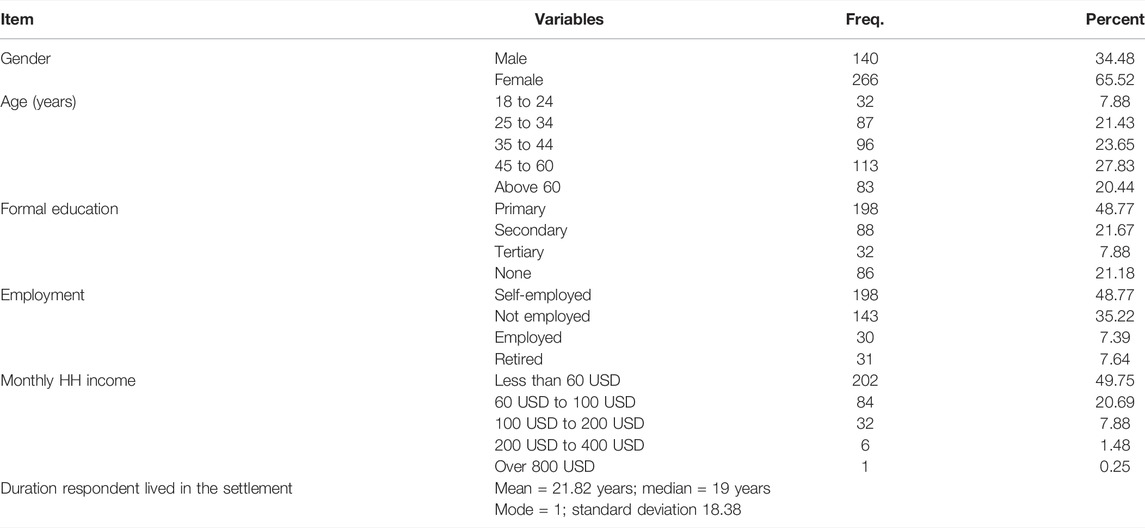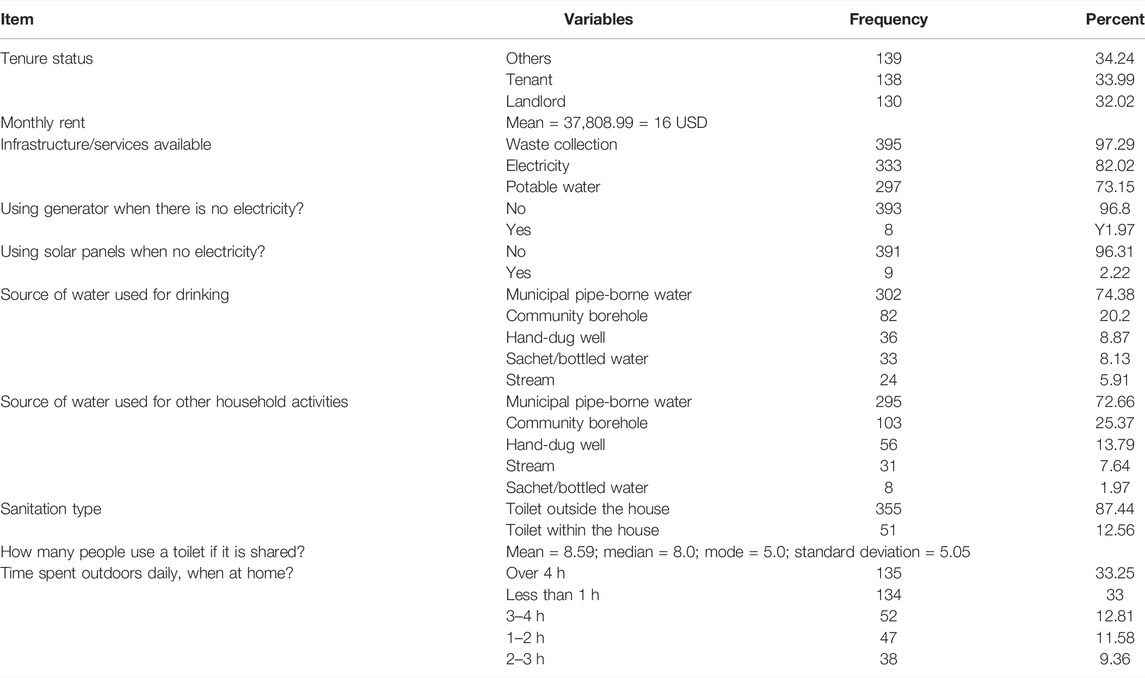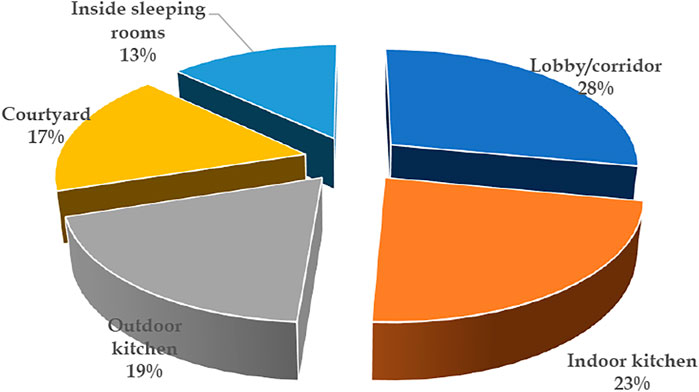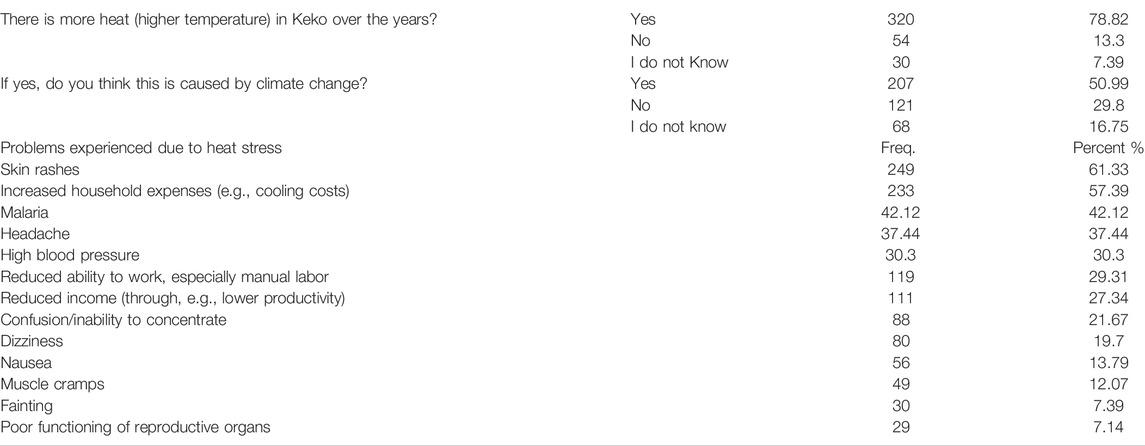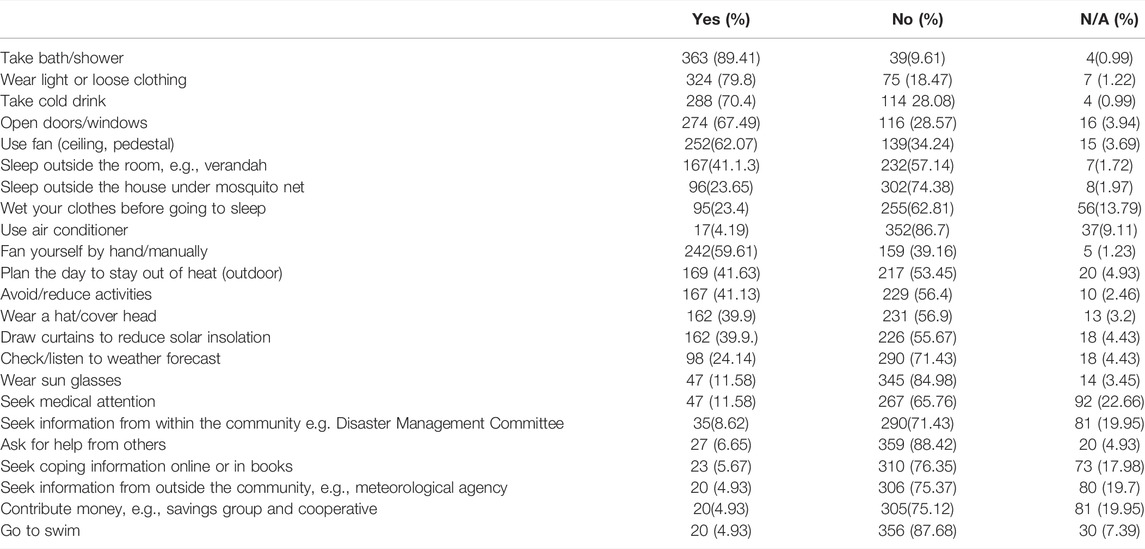- 1Department of Architecture, Federal University of Technology, Akure, Nigeria
- 2Institute of Human Settlements Studies, Ardhi University, Dar es Salaam, Tanzania
Addressing the fallouts of a +1.5°C world is one of the key challenges for urban management in African cities. This article reports a work dealing with climate adaptation in informal urban settlements, with focus on responses to heat stress among the urban poor. The study involved a survey of 405 residents in Keko Machungwa —an unplanned neighborhood in Dar es Salaam, Tanzania. We found that the most popular behavioral responses are taking a shower, wearing light clothing,. drinking cold drinks, and opening doors and windows. The rarest forms of responses are swimming and contributing to savings group. Heat-related health problems experienced by the residents were also identified. Enhancing human responses to heat stress will involve improvement in basic services and infrastructure, awareness, and education among the residents.
Introduction
The experiences of increasing temperature and extreme heat are becoming commonplace. Heat stress refers to heat more than what the body can tolerate without suffering physiological distress and impairment. It generally occurs at temperatures above 35°C, in high-humidity neighborhoods. It is relevant to know what people are currently doing at the individual level and behavioral terms to cope with impacts of heat stress. With the extreme heat experiences, coproduction through lessons from the local communities is a critical strategy for heat adaptation. Understanding individual-level behavioral adaptation is important for improving thermal comfort and resilience to heat stress.
This study considers responses to heat stress among the residents within a low-income and unplanned settlement. The focus on low-income urban settings is important because “for many residents of informal settlements, both the location of the dwelling and the quality of the shelter it provides are vastly inadequate in providing protection from current climate variability and future climate change” (Satterthwaite et al., 2018). Little research in Africa has examined heat-health vulnerability and adaptation among the significant number living within informal settlements (Pasquini et al., 2020). The article begins by establishing, through review of literature, heat vulnerability and challenges as well as human responses in relation to informal urban settlements. Information about the study area, especially the heat-related climate scenarios, was presented in precedence to the section on research methods. The section that presents the results and discusses the research findings follow these.
The Challenge of Heat Extremes in Urban Settings
The combination of urban expansion and climate change heightens the risk of heat stress (Argüeso et al., 2015). It has been recognized that cities contain hot spots of vulnerability in terms of heat-health impacts. Marginalized, low-income groups in cities—those living within slums and informal settlements— appear to have higher heat-related disease burden and mortality. This is particularly important for Africa, where temperatures are projected to increase much higher than the global average.
Likely and/or experienced heat-health challenges within informal settlements have been identified in few available studies. Problems identified in Faisalabad, Pakistan, include dehydration, diarrhea, eye infection, fever, flu (runny nose), headache, nose bleeding, muscular fatigue, and skin allergy (Ehsan et al., 2021). In Ethiopia, malaria, typhoid, and diarrhea were the most likely health threats to informal settlement residents (Bambrick et al., 2015). In Dar, heat stress is more generally linked to tiredness, skin rashes, sleep impairment, and anger/aggression (Pasquini et al., 2020).
The heat-health challenges reduce the quality of life and threaten progress toward SDG 3 (good health and well-being) in the informally settled and low-income areas (Leal Filho et al., 2021; Ncongwane et al., 2021). With projected climate scenarios, heat-related morbidity and mortality are likely to increase. Within relevant heat action plans, especially at the individual level and behavioral responses, these heat-health risks can be prevented or at least reduced (Ebi et al., 2021).
Coping With Heat Stress Within Unplanned Urban Neighborhoods
The challenge of extreme heat is significantly felt within areas categorized as slums and informal settlements in cities. Combining survey data with spatial data on climate from 690,745 households across 52 developing countries, Park et al. (2018) showed that the poorest households often reside and work in the hottest locations. For example, through a survey of 860 households across different housing typologies in Ahmedabad, India, Mahadevia et al. (2020) showed that informal settlement residents experienced higher temperatures (at times up to 7.6°C difference) than people in formal housing. Studies from African countries affirm that increased exposure to heat extremes is a significant problem within the low-income informal neighborhoods. This is established through studies involving temperature data-logging within cities like Nairobi, Kenya (Scott et al., 2017); Accra, Ghana (Wilby et al., 2021); and Kampala, Uganda (Van de Walle et al., 2022).
Increasing resilience to heat stress is important for the low-income urban sector. A range of strategies are possible at the landscape/urban (e.g., blue and green spaces), building (material composition and natural ventilation), and individual (including behavioral) levels (Jay et al., 2021). Responses to heat extreme and ultimately adaptive capacity are generally weak in relation to slums and informal settlements due to low household incomes, weak socioeconomic status, absence of basic services and infrastructure, poor quality of shelter, and so on.
Improving heat resilience through investment in the physical and natural environment (through slum upgrading, building retrofits, green infrastructure, etc.) has been advanced by scholars and practitioners (Loggia et al., 2015; Akinwolemiwa et al., 2018). Non-physical, individual-level strategies are also important while slum dwellers wait for relevant substantive physical interventions. In this regard, local heat action plans which include components of early warning systems, finance mechanism have been recommended for local communities (Pathak and Mahadevia, 2018; Mahadevia et al., 2020).
Different individual-scale heat coping strategies have been practiced, identified, and recommended within the growing corpus of the literature. Notable responses within low-income settings have been identified in a few available studies, for example, in Ehsan et al. (2021) in Faisalabad, responses are drinking water, taking showers during the day, and staying a home. Using fans, hydration, and wearing light clothing were top responses from studies conducted in Ibadan (Taiwo et al., 2012) and Akure (Adegun and Ayoola, 2021). Opening windows/doors and sleeping outside till late night were least practiced in the two cities. Jay et al. (2021) review identified and recommended “cold water foot immersion, wearing a water-saturated T-shirt, seeking shade in well-ventilated areas, doing higher intensity activities at cooler hours, and reducing clothing coverage” during heat extremes in slums and other vulnerable settings.
The result emanating from studies in formal settings within developed countries yield similar findings to those from low-income countries. For example, the literature from Australia (e.g., Soebarto and Bennetts, 2014; Hatvani-Kovacs et al., 2016) and Germany (Großmann et al., 2012) affirm individual-level responses identified within the developing countries. The kind of individual response(s) made are generally influenced by the level of effectiveness, availability, cost, societal norms, and spatial factors (Hwang et al., 2009; Malik et al., 2020). They can also be leveraged for relevant behavioral modifications.
Study Area
This study was conducted in Dar es Salaam (Dar), Tanzania’s commercial hub. It is located on the country’s east coast and has about 5.4 million inhabitants as in 2016 (Tanzania Ministry of Lands, Housing and Human Settlements Development, 2018) (See Figure 1). In Dar, urban poverty and climate variability have jointly created a situation of high vulnerability for the poor. For example, mean annual temperatures have increased by 1°C since 1960s, leading to more hot days and hot nights (Armah et al., 2015). Climate projections indicate that “Dar es Salaam will have more ‘very hot days’ and particularly more ‘very hot nights’ in a year, compared to the historical average, warm spells will also increase.” The total number of very hot days (days when the highest temperature is above 90th percentile, 34.6°C) and very hot nights (nights where the lowest temperature is above 90th percentile, 24.5°C) and warm spells will increase going into 2040. For example, up to 180 very hot days is expected by 2040, an increase from the current 36 very hot days annually (Pasquini et al., 2020). An increasing temperature presents a significant public health challenge.
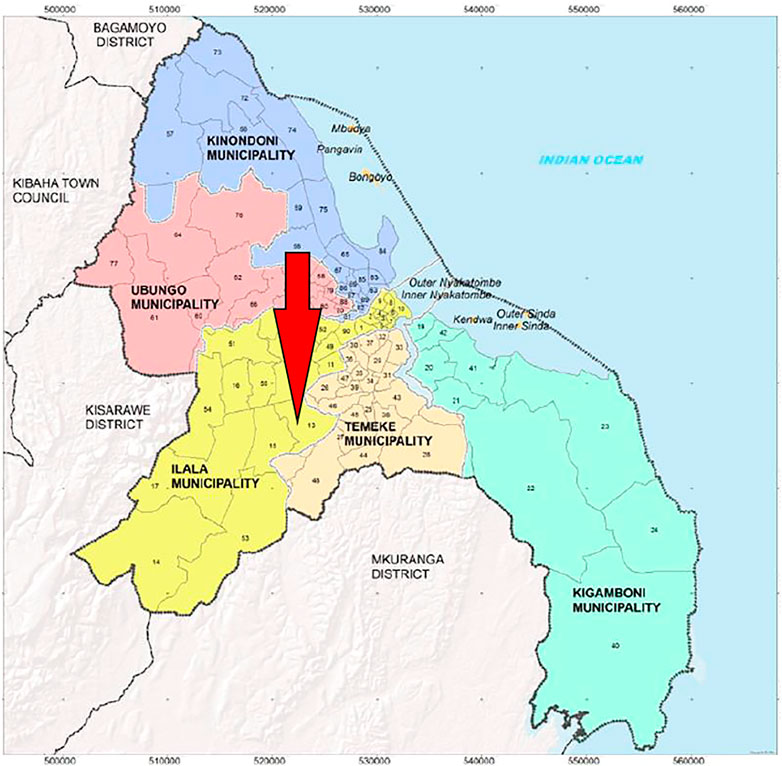
FIGURE 1. Location of Keko Machungwa within Dar es Salaam City (red arrow mark). Source: Draft Dar es Salaam Master Plan (2016–2036).
Over 50% of Dar is unplanned and informal. These informal and unplanned areas continue to densify through migration from different parts of Tanzania to Dar, largely for economic reasons. Rapid urbanization, proliferation of informal settlements, and house densification influence heat stress, especially through urban heat island effect (Argüeso et al., 2015).
Keko Machungwa is one of Dar’s unplanned neighborhoods/informal settlement, and it served as the study area. It lies between latitude 6˚50′10″ and 6˚50′41″ south and between longitude 39˚16′35″ and 36˚17′1″ east. The 1968 Dar es Salaam Master Plan designated significant part of Keko Machungwa as a hazardous zone characterized by frequent water logging (categorized as a wetland area) and hence unsuitable for human settlement development. Based on the 2012 Tanzanian National Population Census, the area had a population of 15,644, distributed across 5,180 households. An estimate of the current figure is about 23,407 persons. The settlement has grown steadily, gaining market value due to its proximity to major infrastructure and commercial hubs. It is approximately 3 km to Dar’s Central Business District (CBD); 400 m from the seaport; 3.1 km to the main railway station, and other nodes which avail livelihood opportunities. Affordable land prices also made Keko Machungwa a prime site for the migrants. Presently, Keko Machungwa is at a saturation stage of development. It has densified over the years, despite inadequate road access, poor sanitation facilities, and a high-water table, causing flood. In terms of heat, Keko Machungwa neighborhood in Dar es Salaam, Tanzania, is very hot although from April to May, the area experiences cool weather compared to the rest of the months.
The Keko Machungwa settlement is dense, with consolidated residential buildings structured detached or organized in compounds (see Figure 2). The Swahili house (see Figure 3) is the predominant housing typology in the settlement. In its modified version, the Swahili house accommodates, features like indoor toilets, individual cooking spaces, or a semi-detached type where two renting households use separate facilities and do not share. Some of the buildings incorporate commercial spaces. Majority of the households have no formal tenure or title. Based on previous studies, one house is occupied by three to six households.
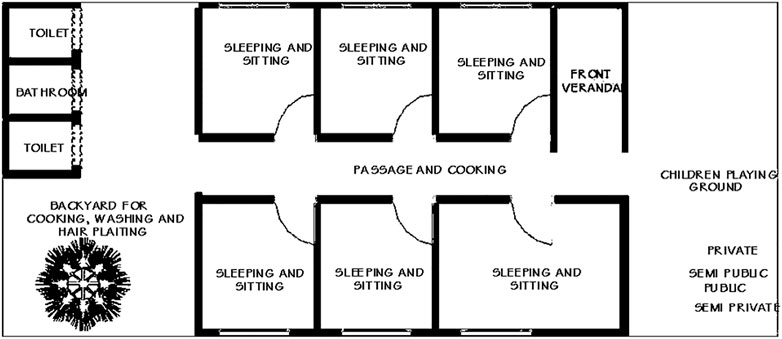
FIGURE 3. Swahili house—typical layout of buildings in Keko Machungwa. Source: Mbuya, 2017.
Research Method
This research utilized a survey for data collection in Keko Machungwa settlement. The survey utilized a questionnaire as research instrument. The questions included were developed through the review of literature (e.g., Taiwo et al., 2012; Hatvani-Kovacs et al., 2016; Adegun and Ayoola, 2021) and earlier engagement with the Keko Machungwa residents during transect walks. The questions were grouped into sections, namely, sociodemographic and housing characteristics, perception of climate change and impacts of heat stress, and individual/behavioral measures in response to heat stress. In the last section, which sought to ascertain the level of adoption, we provided a list (in the questionnaire) of individual and behavioral responses, from which the residents were ticked as appropriate. Also, there was an opportunity to include responses not already listed within the questionnaire.
The total number of residents in Keko Machungwa (estimated at 23,407) served as the study population. We used the popular formula for sample size determination from a given population (see Eq. 1) to arrive at an initial sample size of 385 from the study population. This is at 95% confidence interval and 5% error margin. To make room for incomplete submissions that might be discarded, we eventually engaged 405 residents in the survey.
where S = required sample size; X = value (e.g., 1.96 for 95% confidence level); N = population size; P = population proportion (expressed as decimal)—assumed to be 0.5 (50%); and d = degree of accuracy (5%), expressed as a proportion (0.05)—merging of error.
The survey was conducted between May and July 2020, using KoBoToolbox software. The digital medium precluded the need to carry hard copies of the questionnaire. Also, it was efficient in recording all intended information, while complying with the then COVID-19 safety protocols. A pilot exercise was conducted, after which slight revision of the questions was done. Training exercise was conducted for 5 field assistants, drawn from young graduates affiliated with CityLab Dar es Salaam at the Institute of Human Settlements Studies (IHSS), Ardhi University, Dar es Salaam. The field assistants joined five residents who acted as field guides, and each pair concentrated on a part of the community. The field assistant conducted the survey by asking questions and then entered answers on KoBoToolBox through his/her smartphone. It took an average of 30 min to complete each survey. After completion, all the entries were screened and cleaned, leading to the use of all 405 responses for analysis.
Results
Sociodemographic Variables
The respondents were mostly female (66%), while 34% were male. In terms of age, those aged 18–24 years are 8%, those between 45 and 60 years are 27%, those aged 35–44 years are about 23%, 25–34 years form 21%, and those older 60 years of age are 20% (see Table 1). Majority of the residents have formal education. About half (48.77%) have primary school education; 21.67% have secondary school education; and 8% have tertiary education. Residents’ level of education is a factor in appropriate understanding of climatic phenomena and crucial to packaging awareness initiatives within the community, including adaptation policies and mitigation efforts (Ncongwane et al., 2021).
About half (49%) of the respondents are self-employed, mostly within the informal sector, while 7% are formally employed. About 35% are not employed at all, while 8% are retired. In terms of monthly household income, half of the residents earned less than 150,000 TZS (60 USD) monthly (see Table 1). Only 8% households earned between 250,000 TZS and 500,000 TZS (200 USD), while only 1% earned up to 1,000,000 TZS (400 USD).
Housing Situation and Services
Keko Machungwa residents are either tenants (34%), landlords (32%), or in other categories (34%) (see Table 2). The other categories include those living in inherited or family house, who are neither tenants nor landlords. The mean monthly rent is TZS37808 (16 USD), and the average length of the stay is 21.82 years. Occupancy status tends to determine the quality of a house or an occupied building. The general rule of the thumb is that occupants who are landlords tend to ensure their properties are in good quality, while renters do not.
Most of the respondents have access to water collection (97%) and potable water (73%) and are connected to electricity (82%). Sanitation in the settlement is onsite and largely inadequate. There are two main categories: 87% using shared toilets built outside the house and 13% using toilet within the houses. For shared toilets, the average number using them is 9 people.
Respondents’ housing situation, in terms of space functions for cooking, is shown in Figure 4. We found that 35% of houses have purposely made kitchens, while the greater proportion (63%) do not have purposely made kitchens. When purposively designated, designed, and built cooking spaces are not available, cooking takes place in a range of spaces. Cooking took place at lobbies or verandas (28%), indoor kitchens (23%), in a specially provided outdoor kitchen (19%), and in the courtyard—an open space at the rear of the house (17%). The remainder, approximately 13%, cook inside their sleeping rooms. Cooking in undesignated cooking spaces such as along corridors and sleeping rooms increases the risks of fire outbreak. Furthermore, using undesignated spaces for cooking has negative effects in terms of indoor heat. It significantly increases indoor heat as rooms are typically already congested with other things and activities.
Satisfaction with water, as a basic service, was evaluated in terms of quantity (amount), availability (frequency of flow), and quality (how clean and safe). A high proportion of the residents are satisfied. Water quantity was sufficient to 96%; water availability was sufficient to 90%; and water quality was satisfactory for 91% of the residents (see Figure 5). In response to satisfaction levels for solid waste management, particularly waste collection services, 29% of the residents were highly satisfied, 25% moderately satisfied, 20% were dissatisfied, 14% were indifferent; and 12% were highly dissatisfied. The provision of electrical supply services was valued differently with only 29% satisfied, 26% very satisfied, 16% very dissatisfied, 12% dissatisfied, and 10% neutral.
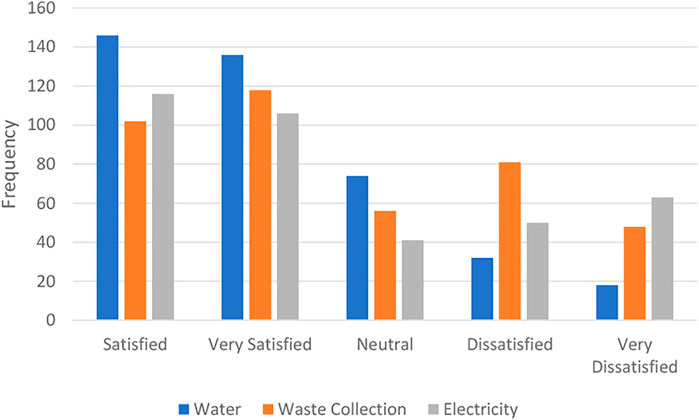
FIGURE 5. Chart showing the level of satisfaction with available services. Source: Field work, 2020.
Perception on Heat Stress
About 79% of the residents agree that temperature in Keko Machungwa has gradually increased over the years. Very few residents do not think that temperature is increasing, or they were just indifferent. While city-scale climate data show increasing temperature, our study could not access long- or short-term temperature data to ascertain the popular opinion of temperature increase within the case study settlement. Among residents who have observed temperature increase, 50% think it is climate change, while 30% think it is not climate change (see Table 3). While some respondents could not attribute to extreme heat to any cause, others attributed it to the following:
1 Densification: This is described through the terms such as “house concentration,” “high concentration of houses,” “house congestion,” “houses being too close to each other,” and “house overcrowding.”
2) Absence of green structures (tress and grasses): Houses generally lack ample green spaces. A few trees available are scattered away from each other. In most areas, there is one or two trees in a stretch of more than 10 dwellings (see Figure 6).
3) House and site form: orientation of the Sun contributes to indoor heat and subsequently heat stress. The fenestrations of many rooms face the sunset, so heat is higher at night than at daytime. Additionally, “head room” (floor-to-ceiling height) of houses are relatively short, disallowing easier heat loss. Air circulation around houses is poor since little space is left after the entire plots are built up.
4) Sanitation practices: Foul smell from uncollected waste and wastewater worsens the situation during hot days, given the fact that there is very limited air circulation. Burning uncollected waste causes heat.
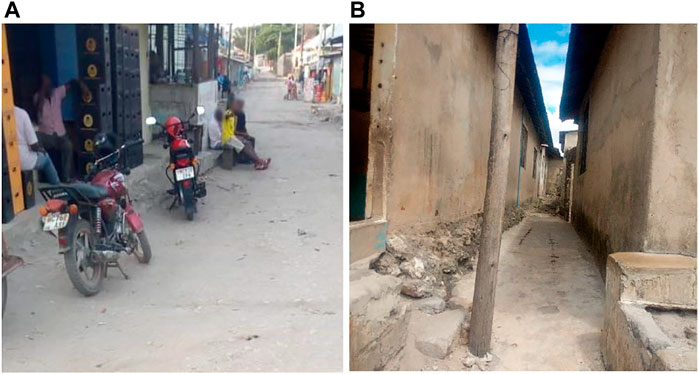
FIGURE 6. Long stretch of street with just one tree (A). Stretch of houses without trees/greenery in between (B). Pictures taken by Olumuyiwa Adegun, September 2019.
Heat-Health Challenges
The respondents self-reported health challenges that they have experienced and can attribute to increasing heat in the settlement. Typical problems reported are skin rashes (61%), malaria (42%), recurring headaches (38%), high blood pressure (30%), dizziness (20%), confusion, and inability to concentrate (22%). Problems such as nausea (14%), muscle cramps (15%), fainting (7%), and poor function of reproductive organs (7%) were also reported. Other problems reported, although not directly related to health, higher cooling costs (57%) and lower performance by employees (29%) (see table 3).
Individual/Behavioral Responses
Table 4 shows proportions of the residents who used different responses. Bathing/taking showers regularly during the day (89%) was the most reported, although majority of those applying this strategy complained of increasing costs associated with additional water consumption. Wearing light or loose clothing (79%), taking cold drinks (70%), open doors/windows (67%), and using fans (62%) were also among the top responses. Swimming, seeking information from outside the community, and financial contributions toward disaster preparedness fund on heat stress were not popular—only practiced among less than 5% of the residents. A small percentage (4%) of the respondents use air conditioners.
Discussion
From the study, it appears that the residents are aware that increasing temperature is not only linked to climate change but also associated with urban heat island. The heat island situation emanates from dense, sparingly vegetated nature of the settlement. Based on studies from other settlement in Dar, Roy et al. (2018) even argued that few available green spaces are declining. Given the continued competition for land, near impossibility of de-densifying, little space/vertical greening structures offer a veritable means to greening the settlement—tackling urban heat island and climate change together.
The reported health problems represent some of the common illnesses in the hot-humid tropical case study area. This shows that heat stress is a contributory factor to disease burdens in the informal settlement. Measures addressing public health challenges therefore must include heat action plans involving individual-/behavioral-level responses.
The most popular responses (taking a shower, wearing light clothing, cold drinks, and opening doors and windows) that the residents make in this study align with those identified in earlier studies (see e.g., Taiwo et al., 2012; Adegun and Ayoola, 2019; Ehsan et al., 2021). They align with those recommended by the health experts for heat-vulnerable settings such as Keko Machungwa (Jay et al., 2021). These responses involve little or no cost, hence their popularity in this low-income setting. Availability of and relative satisfaction with services (water and electricity) in the case study area must have supported popularity of these practices.
The very low use of air conditioners in informal settlement such as Keko Machungwa is notable, although it is not new in the literature. The costs involved in installing and operating air conditioners are not affordable in the low-income settings. Apart from cost, its disadvantages in terms of energy and perceptual adaptation to heat have been explained (Parkes et al., 2019; Jay et al., 2021). Since air conditioners are few, the residents often sleep outside the room and outside the house during the day or at night. These however come with the risk of insect bites (especially mosquitoes which bring malaria), security threats, and other safety concerns. The challenge is to develop and use the least-cost energy cooling system in the future.
Other rare responses—swimming and contributing to savings group—reflect conditions within the community. No swimming pool was identified in the area, and the adjoining stream and wetland are not suitable for swimming. Financial contributions toward heat-related disaster preparedness, although rarely practiced, have potentials. Only 4% of the respondents showed willingness, and 81% think that it is not applicable, which can be explained through lack in financial ability and/or incognizance on potentials of the initiative.
Effectiveness of the diverse responses will largely depend on adequacy and maximal satisfaction with basic services and infrastructure, especially potable water, for drinking, showering, and electricity for cooling. Keeping the environment safe and clean through adequate proper waste disposal/collection and drainage is crucial for cooling tendencies of spending time in outdoor spaces. What count as acceptable or unacceptable sociocultural practices is also a factor. For instance, the purdah system will affect how women respond to heat through their clothing (Malik et al., 2020).
Conclusion
The case of Keko Machungwa settlement in Dar es Salaam has shown perceptions and problems experienced in relation to heat stress, as well as individual-level/behavioral responses by poor people within low-income, informal urban communities. The popular responses are enabled through available services, while the rarest ones are constrained through lack in infrastructure and poor awareness of their potentials. The health challenges reported shows that heat adaptation action should be an integral part of public health strategies. Additionally, there is need for increased awareness and community organization for capacitation and behavioral changes in this kind of low-income and unplanned urban neighborhood.
We could not access or generate the long- or short-term wet-bulb temperature data in this study. This represents a limitation that can be addressed in future studies incorporating the microclimate data logging. It is important to understand the indoor–outdoor differences across the diverse responses and the range of factors that influence the responses in the low-income and informal urban setting.
Data Availability Statement
The raw data supporting the conclusion of this article will be made available by the authors, without undue reservation.
Author Contributions
OA: study conception and design, data analysis and interpretation, and writing drafts. EM: study design, data collection, and writing drafts. EN: data collection and analysis, and writing drafts.
Conflict of Interest
The authors declare that the research was conducted in the absence of any commercial or financial relationships that could be construed as a potential conflict of interest.
Publisher’s Note
All claims expressed in this article are solely those of the authors and do not necessarily represent those of their affiliated organizations, or those of the publisher, the editors, and the reviewers. Any product that may be evaluated in this article, or claim that may be made by its manufacturer, is not guaranteed or endorsed by the publisher.
Acknowledgments
The fieldwork was supported through the Climate Research for Development (CR4D) Postdoctoral Fellowship (CR4D-19-03) implemented by the African Academy of Sciences (AAS). Statements made and views expressed in this work are solely the responsibility of the author(s).
References
Adegun, O. B., and Ayoola, H. A. (2019). Adaptation to Heat Stress within Housing Estates in Akure, Nigeria. Covenant J. Res. Built Environ. 7 (1, 51–62. doi:10.20370/45y0-hs42)
Adegun, O. B., and Ayoola, H. A. (2021). Between the Rich and Poor: Exposure and Adaptation to Heat Stress across Two Urban Neighbourhoods in Nigeria. Environ. Develop. Sustainability, 1–16. doi:10.1007/s10668-021-01924-w
Akinwolemiwa, O. H., de Souza, C. B., De Luca, L. M., and Gwilliam, J. (2018). Building Community-Driven Vertical Greening Systems for People Living on Less Than£ 1 a Day: A Case Study in Nigeria. Build. Environ. 12 (2), 277–287.
Argüeso, D., Evans, J. P., Pitman, A. J., and Di Luca, A. (2015). Effects of City Expansion on Heat Stress under Climate Change Conditions. PLoS ONE 10 (2), e0117066. doi:10.1371/journal.pone.0117066
Armah, F. A., Yengoh, G. T., Luginaah, I., Chuenpagdee, R., Hambati, H., and Campbell, G. (2015). Monitored Versus Experience-Based Perceptions of Environmental Change: Evidence from Coastal Tanzania. J. Integrat. Environ. Sci. 12 (2), 119–152. doi:10.3389/fbioe.2021.750258
Bambrick, H., Moncada, S., and Briguglio, M. (2015). Climate Changeand Health Vulnerability in Informal Urban Settlements in the Ethiopian Rift Valley. Environ. Res. Lett. 10 (5), 1–13. doi:10.1088/1748-9326/10/5/054014
Ebi, K. L., Capon, A., Berry, P., Broderick, C., de Dear, R., Havenith, G., et al. (2021). Hot Weather and Heat Extremes: Health Risks. Lancet 398 (10301), 698–708. doi:10.1016/s0140-6736(21)01208-3
Ehsan, S., Abbas, F., Ibrahim, M., Ahmad, B., and Farooque, A. A. (2021). Thermal Discomfort Levels, Building Design Concepts, and Some Heat Mitigation Strategies in Low-Income Communities of a South Asian City. Int. J. Environ. Res. Public Health 18, 2535. doi:10.3390/ijerph18052535
Großmann, K., Franck, U., Krüger, M., Schlink, U., Schwarz, N., and Stark, K. (2012). Soziale Dimensionen von Hitzebelastung in Großstädten. disP—The Plann. Rev. 48 (4), 56–68. doi:10.1080/02513625.2012.776818
Hatvani-Kovacs, G., Belusko, M., Skinner, N., Pockett, J., and Boland, J. (2016). Drivers and Barriers to Heat Stress Resilience. Sci. Total Environ. 571, 603–614. doi:10.1016/j.scitotenv.2016.07.028
Hwang, R.-L., Cheng, M.-J., Lin, T.-P., and Ho, M.-C. (2009). Thermal Perceptions, General Adaptation Methods and Occupant's Idea about the Trade-Off between thermal comfort and Energy Saving in Hot-Humid Regions. Building Environ. 44 (6), 1128–1134. doi:10.1016/j.buildenv.2008.08.001
Jay, O., Capon, A., Berry, P., Broderick, C., de Dear, R., Havenith, G., et al. (2021). Reducing the Health Effects of Hot Weather and Heat Extremes: from Personal Cooling Strategies to green Cities. Lancet 398 (10301), 709–724. doi:10.1016/s0140-6736(21)01209-5
Leal Filho, W., Wolf, F., Castro-Díaz, R., Li, C., Ojeh, V. N., Gutiérrez, N., et al. (2021). Addressing the Urban Heat Islands Effect: A Cross-Country Assessment of the Role of Green Infrastructure. Sustainability 13, 753. doi:10.3390/su13020753
Loggia, C., Tramontin, V., and Trois, C. (2015). Sustainable Housing in Developing Countries: Meeting Social and Environmental Targets by “Greening” Low-Income Settlements in South Africa. Int. J. Sustain. Policy Pract. 9 (4), 1–12. doi:10.18848/2325-1166/CGP/v09i04/55432
Mahadevia, D., Pathak, M., Bhatia, N., and Patel, S. (2020). Climate Change, Heat Waves and Thermal Comfort-Reflections on Housing Policy in India. Environ. Urbanization ASIA 11 (1), 29–50. doi:10.1177/0975425320906249
Malik, J., Bardhan, R., Hong, T., and Piette, M. A. (2020). Contextualising Adaptive Comfort Behaviour within Low-Income Housing of Mumbai, India. Building Environ. 177, 106877. doi:10.1016/j.buildenv.2020.106877
Mbuya, E. (2017). Vulnerability Analysis of Building Structures to Climate Change: The Case of Flooding in Informal Settlements in Dar Es Salaam, Tanzania. Unpublished PhD thesis. Dar es Salaam, Tanzania: Ardhi University.
Ncongwane, K. P., Botai, J. O., Sivakumar, V., and Botai, C. M. (2021). A Literature Review of the Impacts of Heat Stress on Human Health across Africa. Sustainability 13, 5312. doi:10.3390/su13095312
Park, J., Bangalore, M., Hallegatte, S., and Sandhoefner, E. (2018). Households and Heat Stress: Estimating the Distributional Consequences of Climate Change. Envir. Dev. Econ. 23, 349–368. doi:10.1017/s1355770x1800013x
Parkes, B., Cronin, J., Dessens, O., and Sultan, B. (2019). Climate Change in Africa: Costs of Mitigating Heat Stress. Climatic Change 154, 461–476. doi:10.1007/s10584-019-02405-w
Pasquini, L., van Aardenne, L., Godsmark, C. N., Lee, J., and Jack, C. (2020). Emerging Climate Change-Related Public Health Challenges in Africa: A Case Study of the Heat-Health Vulnerability of Informal Settlement Residents in Dar Es Salaam, Tanzania. Sci. Total Environ. 747, 141355. doi:10.1016/j.scitotenv.2020.141355
Pathak, M., and Mahadevia, D. (2018). “Urban Informality and Planning: Challenges to Mainstreaming Resilience in Indian Cities,” in Resilience-Oriented Urban Planning, Lecture Notes in Energy. Editors Y. Yamagata, and A. Sharifi (Cham, Switzerland: Springer Publishing AG), 65, 49–66. doi:10.1007/978-3-319-75798-8_3
Roy, M., Shemdoe, R., Hulme, D., Mwageni, N., and Gough, A. (2018). Climate Change and Declining Levels of Green Structures: Life in Informal Settlements of Dar es Salaam. Tanzania Landscape Urban Plan. 180, 282–293.
Satterthwaite, D., Archer, D., Colenbrander, S., Dodman, D., Hardoy, J., and Patel, S. (2018). “Responding to Climate Change in Cities and in Their Informal Settlements and Economies,” in Paper prepared for the IPCC for the International Scientific Conference on Cities and Climate Change in Edmonton, Edmonton, Canada, March 5–7, 2018. (Edmonton, UK: International Institute for Environment and Development IIED).
Scott, A. A., Misiani, H., Okoth, J., Jordan, A., Gohlke, J., Ouma, G., et al. (2017). Temperature and Heat in Informal Settlements in Nairobi. PloS one 12 (11), e0187300. doi:10.1371/journal.pone.0187300
Soebarto, V., and Bennetts, H. (2014). Thermal comfort and Occupant Responses during Summer in a Low to Middle Income Housing Development in South Australia. Building Environ. 75, 19–29. doi:10.1016/j.buildenv.2014.01.013
Taiwo, O. J., Olaniran, H. D., and Osayomi, T. (2012). Perceived Causes, Exposures and Adjustments to Seasonal Heat in Different Residential Areas in Ibadan, Nigeria. Environmentalist 32 (4), 405–414. doi:10.1007/s10669-012-9403-8
Tanzania Ministry of Lands, Housing and Human Settlements Development (2018). Dar es salaam Masterplan 2016-2036.
Van de Walle, J., Brousse, O., Arnalsteen, L., Brimicombe, C., Byarugaba, D., Demuzere, M., et al. (2022). Lack of Vegetation Exacerbates Exposure to Dangerous Heat in Dense Settlements in a Tropical African City. Environ. Res. Lett. 17 (2), 024004. doi:10.1088/1748-9326/ac47c3
Keywords: heat adaptation, thermal comfort, slum upgrading, heat-resistant housing, heat-health risk
Citation: Adegun OB, Mbuya EC and Njavike E (2022) Responses to Heat Stress Within an Unplanned Settlement in Dar Es Salaam, Tanzania. Front. Built Environ. 8:874751. doi: 10.3389/fbuil.2022.874751
Received: 12 February 2022; Accepted: 04 April 2022;
Published: 04 May 2022.
Edited by:
Ayman Mahmoud, Cairo University, EgyptReviewed by:
Giles Bruno Sioen, The University of Tokyo, JapanGraziano Salvalai, Politecnico di Milano, Italy
Copyright © 2022 Adegun, Mbuya and Njavike. This is an open-access article distributed under the terms of the Creative Commons Attribution License (CC BY). The use, distribution or reproduction in other forums is permitted, provided the original author(s) and the copyright owner(s) are credited and that the original publication in this journal is cited, in accordance with accepted academic practice. No use, distribution or reproduction is permitted which does not comply with these terms.
*Correspondence: Olumuyiwa Bayode Adegun, bXV5aXdhYWRlZ3VuQHlhaG9vLmNvLnVr, b2JhZGVndW5AZnV0YS5lZHUubmc=; Emmanuel Njavike, ZW5qYXZpa2VAZ21haWwuY29t
 Olumuyiwa Bayode Adegun
Olumuyiwa Bayode Adegun Elinorata Celestine Mbuya2
Elinorata Celestine Mbuya2